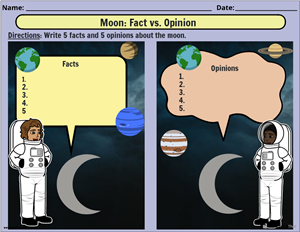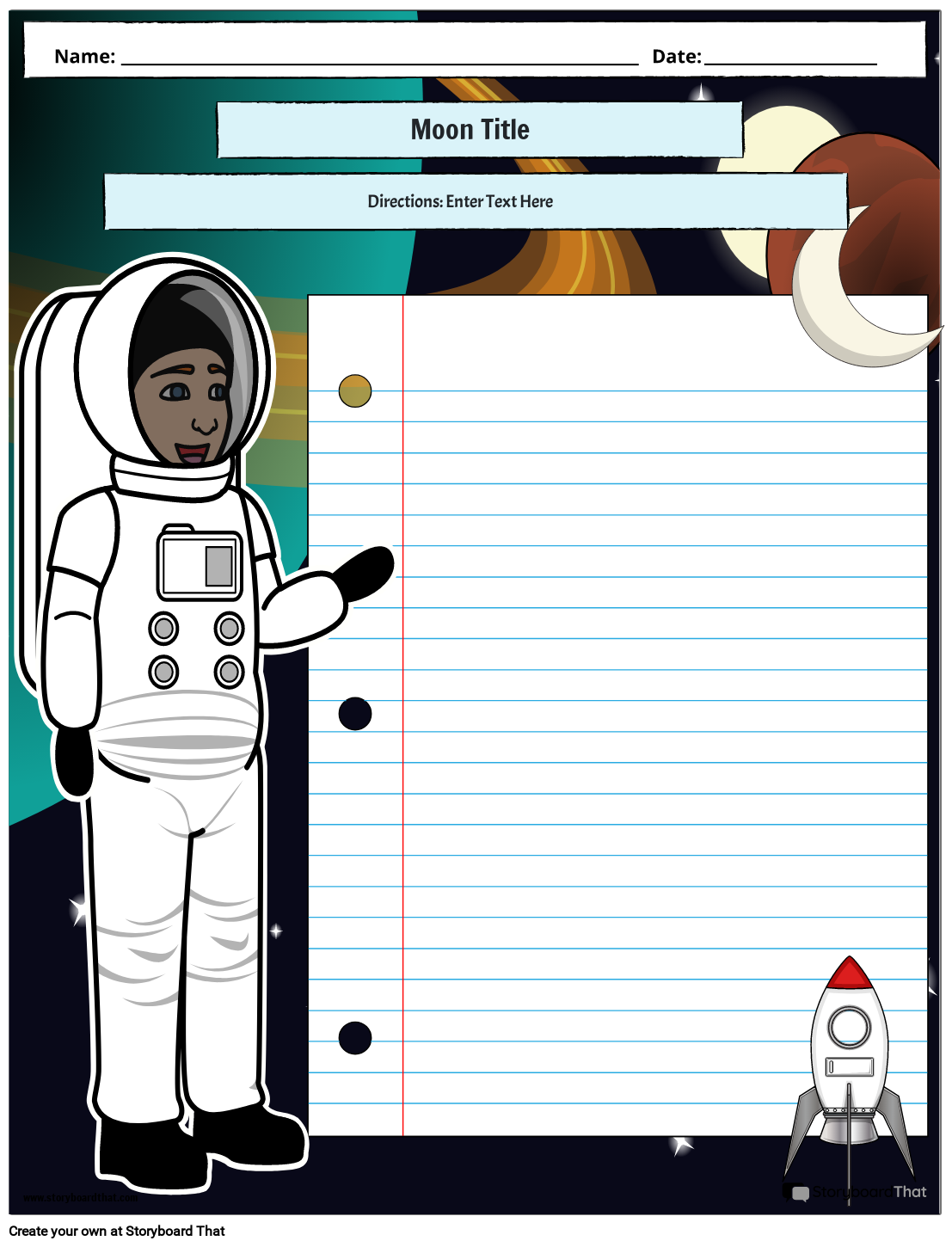Customize Moon Worksheets
If you're assigning this to your students, copy the worksheet to your account and save. When creating an assignment, just select it as a template!

Using Worksheets to Teach About the Moon
The moon, Earth's constant companion in the sky, has captivated humans for centuries. From its mesmerizing phases to the mysteries of its lunar landscape, it continues to inspire curiosity and wonder. Exploring its various phases, history of exploration, and its role in our solar system is useful whether you're a student, educator, or simply someone intrigued by the cosmos.
Teaching the Moon's Vital Stats, its Phases and its Impact
The moon is Earth's natural satellite, a spherical body with a diameter of about 2,159 miles (3,474 kilometers). It orbits Earth at an average distance of 238,855 miles (384,400 kilometers) and is an integral part of our solar system. To teach kids about these phases, educators often use tools like a phases worksheet or an "Oreo moon phases worksheet.” These interactive activities allow children to model, draw, and explain phases by using Oreo cookies to mimic the moon's different appearances as it orbits Earth. This engaging approach helps students grasp the concept of the moon's phases, from the new moon to the first quarter moon and beyond.
Lunar Landscapes: Craters, Maria, and More
When we gaze at the sky, we see more than just different phases; we also observe a rich tapestry of lunar landscapes. The moon's surface is adorned with craters, vast plains called "maria," rugged highlands, and towering mountains. These features were formed through eons of meteoroid impacts and volcanic activity, providing valuable insights into our solar system's history.
The Dark Side of the Moon
One of the moon's most intriguing aspects is its synchronous rotation, which means we only see one side of it from Earth. However, there is no "dark side" in the sense of perpetual darkness. The term simply refers to the side that faces away from Earth. It orbits our planet, and as it does, it reveals different phases to observers in the northern hemisphere.
Moon-Watching Tips for Amateurs
For those eager to explore the sky and observe the moon's phases, there are numerous resources available. Whether you're using a telescope, binoculars, or just your naked eye, the moon is a readily accessible celestial object for stargazers of all ages. Free printable moon phases worksheets and "identifying phases of the moon worksheets" can assist students and amateurs alike in their lunar-gazing adventures.
Worksheet Ideas
Primary Level: 1st - 3rd Grade
- Oreo Moon’s Phases Worksheet: Have students use Oreo cookies to represent the phases of the moon, such as a waxing crescent moon or a waning gibbous moon. They can draw and label each phase on their moon phases worksheet, helping them understand the lunar cycle in a tasty and interactive way.
- Drawing Moon Phases Worksheet: Provide students with a blank moon phases worksheet and encourage them to draw the moon as it appears in various phases. This activity helps them develop observational skills and learn about the moon's changing appearance.
- Phases Circle Activity: Create a large circle on the floor and have students stand around it. Use flashlights to represent the sun, and as you shine the light on the circle, ask students to move to show the position of the moon during different phases. This hands-on activity reinforces the concept of the moon's orbit around Earth.
Intermediate Level: 4th - 6th Grade
- Lunar Cycle Observation Journal (Moon Phases Worksheet Free): Give students a printable phases of the moon worksheet and ask them to observe and record the moon's rotation over several weeks. They can use their worksheets to sketch the moon's appearance and note the date and time of each observation. This activity helps them understand the recurring lunar cycle.
- Phases of the Moon Worksheet Cut and Paste Flipbook: Give students a worksheet that includes images of phases of the moon. Ask them to cut out each phase and create a flipbook that shows the transition from one phase to the next. This activity makes learning about phases hands-on and engaging.
Middle School Level: 7th - 9th Grade
- Predicting Moon Phases Worksheet: Provide students with a worksheet that includes dates and times. Ask them to predict the moon's phase for each date and then check their predictions against actual observations. This activity reinforces their understanding of the moon's orbital patterns.
- Night Sky Observation: Organize an outdoor sky observation session. Have students use a worksheet to record their observations of the moon's phase, along with other celestial objects like planets and stars. This activity connects lunar phases to the broader context of the sky.
High School Level: 10th - 12th Grade
- Lunar Cycle Simulation: Use a digital simulation or model to demonstrate how the moon's orbit around Earth results in different phases. Have students analyze the simulation and complete a moon worksheet that includes questions about the lunar cycle.
- Comparing Earth's Phases: Have students compare and contrast the rotation of the moon with the day-night cycle on Earth. Use a worksheet to guide their analysis and discussions about the relationship between Earth's orbit around the sun and the moon's phases.
- Moon Phases and Tides: Explore the connection between phases of the moon and tides. Provide students with data on tides for a specific location and ask them to use their knowledge of lunar orbit and rotation, from a waxing crescent moon to a waning crescent moon, to explain the variations in tidal patterns.
Steps to Make a Moon Phases Worksheet
- Define Your Objectives: Determine the educational goals of your worksheet. Decide whether it will focus on basic phases of the moon, incorporate hands-on activities or include more advanced concepts.
- Content and Layout: Outline the content and layout of the worksheet. Include sections for drawing or labeling phases of the moon, explanations, or predictions.
- Clear Instructions: Provide clear and concise instructions for each section. Specify whether students should use visual aids like Oreos, draw a phase of the moon like a half moon or a full moon, or answer questions about the lunar cycle. Including a moon phases worksheet answer key is useful since it serves as a valuable resource for students to independently check their work and reinforce their understanding of lunar phases, promoting self-assessment and learning autonomy. Moon activity worksheet instructions should be clear and concise, guiding students through the process of observing, recording, and analyzing lunar phases to enhance their comprehension of this astronomical phenomenon.
- Engaging Activities: If relevant, include engaging activities, such as predicting lunar phases or conducting experiments. Encourage hands-on learning and critical thinking.
- Visual Elements: Add visual elements like images of lunar phases, diagrams of the Earth-moon-sun system, or illustrations of celestial events to enhance comprehension and make the worksheet visually appealing.
- Accessibility: Consider making your lunar phases worksheet accessible by providing a downloadable, printable version for educators and students. If possible, offer it as a free moon phases worksheet resource online for wider distribution.
By following these steps, you can create an informative and engaging lunar phases worksheet that aligns with your educational objectives and incorporates key elements such as hands-on activities and answer keys.
More Storyboard That Resources and Free Printables
How to Make a Moon Worksheet
Choose One of the Premade Templates
We have lots of templates to choose from. Take a look at our example for inspiration!
Click on "Copy Template"
Once you do this, you will be directed to the storyboard creator.
Give Your Worksheet a Name!
Be sure to call it something related to the topic so that you can easily find it in the future.
Edit Your Worksheet
This is where you will include directions, specific images, and make any aesthetic changes that you would like. The options are endless!
Click "Save and Exit"
When you are finished, click this button in the lower right hand corner to exit your storyboard.
Next Steps
From here you can print, download as a PDF, attach it to an assignment and use it digitally, and more!
Happy Creating!
Frequently Asked Questions about Moon Worksheets
In what ways do moon phases worksheets encourage critical thinking and problem-solving skills in students?
Moon phases worksheets encourage critical thinking and problem-solving skills in students by requiring them to observe, analyze, and compare the moon's changing appearance. They promote pattern recognition, deductive reasoning for predicting future phases, and the application of scientific concepts, fostering analytical thinking and problem-solving. Students also engage in self-assessment, identifying errors and improving their understanding. Additionally, connecting moon phases to real-world scenarios and interdisciplinary topics enhances the relevance and complexity of problem-solving tasks, making these worksheets valuable tools for developing critical thinking skills.
Are there any creative activities or projects that complement moon phases worksheets and further deepen students' understanding of lunar concepts?
Certainly! Creative activities and projects that complement moon phases worksheets include crafting 3D moon phase models, designing lunar calendars, conducting lunar observations, creating moon phase art and poetry, exploring moon phase mythology, and crafting moon phase mobiles. Additionally, students can investigate the connection between moon phases and tides, engage in digital projects, plan hypothetical lunar missions, write moon phase-inspired stories, and use interactive moon phase apps. These hands-on and imaginative activities deepen students' understanding of lunar concepts while fostering creativity and engagement.
How can educators use worksheets as part of a larger unit on the moon and the solar system to provide a comprehensive learning experience?
Educators can enhance a comprehensive unit on the moon and the solar system by using worksheets strategically. Begin with assessments and sequential learning, progressing from foundational to more complex topics. Incorporate hands-on activities, cross-disciplinary connections, and critical thinking challenges using worksheets. Integrate interactive technology and group projects to engage students collaboratively. Use worksheets for progress assessments, reflection, and discussion. Finally, conclude with culminating projects to synthesize knowledge. This structured approach reinforces key concepts and caters to various learning styles throughout the unit.
© 2025 - Clever Prototypes, LLC - All rights reserved.
StoryboardThat is a trademark of Clever Prototypes, LLC, and Registered in U.S. Patent and Trademark Office








